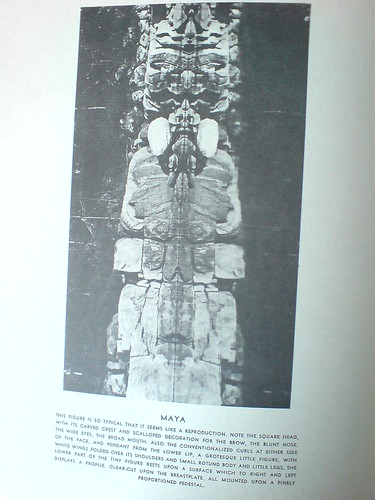
I found a beautiful and odd book the other day, Reflections: The Story of Water Pictures, published in 1936 by Marion Thayer MacMillan.
While vacationing in the Indian territories surrounding Georgian Bay on Lake Ontario, soon after the end of World War I, McMillan discovered a Rorschach-like phenomenon where still waters would occasionally produce perfect mirror images of the craggy coastline.
Over 15-plus years studied and photographed perfectly mirrored reflections along the coastline of Georgian Bay, Lake Ontario. [She tells of teaching herself photography in order to capture these ephemeral landscape images.]
MacMillan began showing her photos around, first to the local population and Indian craftsmen, and she came to the conclusion that such visual phenomena were apparent to centuries of canoeing Indians, who drew inspiration from them for their myths and artifacts. She particularly saw radially symmetric totem poles as permanent representations of these phenomena.

Eventually, she began giving slide lectures of the photos at museums, universities, and art societies, where she drew connections between this “primitive” visual language, which was surely a common thread among all “savage” cultures, and the most advanced modernist, abstractionist movement being put forward in the art world of the day.

And so the caption on her photo, titled Child’s Head by Brancusi, reads, “The oval of the child’s face, with bend head, fingers in mouth, is so obvious that it needs no description.”
Many, or really most, of her photos are similarly titled and labeled; in her search for meaning in this optical, perceptual phenomenon, MacMillan repeatedly found “obvious” representations of artistic, literary, and religio-spiritual subjects. Which only temporarily distracts from the beauty and now-historically tinged aesthetic of the images themselves. I imagine there are some sexy, old prints out there somewhere.
The art and anthropology worlds seem to have been politely intrigued but largely unaffected my Mrs. MacMillan’s work or discoveries. Though she does mention a photographer she’d introduced the effect to had taken some accomplished Water Pictures of her own, which she showed at Julien Levy’s gallery, to generally positive reviews.
Basically, as long-lost art goes, MacMillan’s book doesn’t feel like a masterpiece, or even that important. In one way, I feel a bit implicated, as I sit here, finding or creating world-changing images and rewriting art history, in my little blog canoe. But then, it was important to her, and maybe it’s enough to recognize that.
Reflections: The Story of Water Pictures is usually available on Abebooks, though my $20 inscribed copy seems like an outlier [abebooks]
I posted a couple more images in the gregorg flickr [flickr]
Skip to content
the making of, by greg allen
